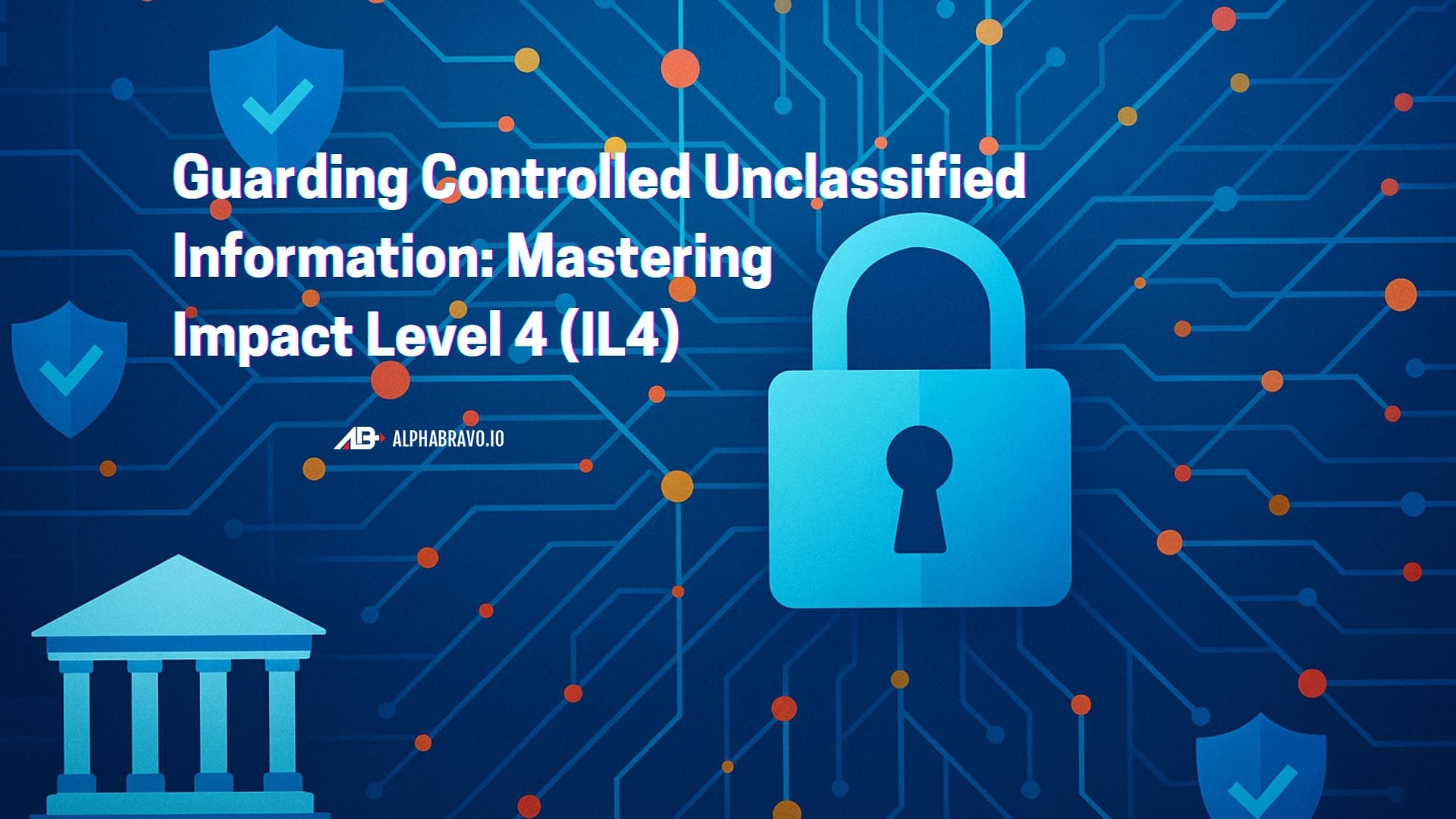Guarding Controlled Unclassified Information: Mastering Impact Level 4 (IL4)
Mastering DoD Impact Level 4 is essential for securing Controlled Unclassified Information—combining rigorous FedRAMP High controls, U.S.-only data residency, and mission-grade protections to enable trusted operations across the defense ecosystem.

The Department of Defense (DoD) handles vast amounts of sensitive information that, while not classified, still requires robust protection from unauthorized access or disclosure. Impact Level 4 (IL4) provides the framework and controls necessary to safeguard this Controlled Unclassified Information (CUI). This article explores the intricacies of IL4, its specific security requirements, and practical implementation strategies to help organizations achieve and maintain compliance.
Understanding DoD Impact Level 4
Impact Level 4 represents a critical security tier within the Department of Defense's Cloud Computing Security Requirements Guide (CC SRG). It's designed specifically for non-classified information that requires substantial protection due to its sensitivity and potential impact if compromised.
What Exactly Is IL4?
IL4 accommodates Controlled Unclassified Information (CUI) and other mission-critical data that, while unclassified, could severely impact organizational operations, assets, or individuals if improperly disclosed. It serves as the security standard for non-public information that doesn't fall under national security classification but still demands rigorous protection.
Types of Information Covered Under IL4
IL4 encompasses several categories of sensitive information:
- Personally Identifiable Information (PII): Including military personnel records in HR forms
- Protected Health Information (PHI): Health records that fall under privacy laws
- For Official Use Only (FOUO) data: Information specifically designated for limited distribution
- Export-controlled information: Including items under Export Administration Regulations (EAR) and International Traffic in Arms Regulations (ITAR)
- Critical infrastructure information: Such as energy infrastructure data
- Financial information: Including bank secrecy and budget data
IL4 notably does not accommodate classified information (Secret or Top Secret), which requires higher impact levels.
Security Requirements for IL4 Compliance
Achieving IL4 compliance requires meeting stringent security standards that significantly exceed those of lower impact levels.
FedRAMP High Baseline Plus DoD Controls
The foundation of IL4 security is the FedRAMP High baseline, which consists of 421 security controls designed to prevent disastrous consequences such as financial ruin or loss of life. This baseline is then augmented with additional DoD-specific controls to meet military requirements.
The total security control count for IL4 is 369 controls, including all those from FedRAMP Moderate plus additional controls specific to DoD environments. These controls span numerous domains including:
- Access control
- Encryption requirements
- Incident response
- Continuous monitoring
- Identity management
- System and communications protection
Geographic Requirements: U.S.-Only Data Residency
Unlike lower impact levels, IL4 mandates that all data must reside within U.S. territory or U.S.-controlled facilities. This geographical restriction ensures that CUI remains under U.S. jurisdiction and legal protections at all times.
Connectivity Through NIPRNet
Systems handling IL4 data must connect through the Non-Classified Internet Protocol Router Network (NIPRNET), which provides a more secure communication channel than the public internet. This requirement establishes a controlled boundary for information exchange and limits exposure to external threats.
Personnel Requirements
IL4 environments impose strict requirements on who can access the systems and data:
- Personnel must undergo background checks
- Signed non-disclosure agreements (NDAs) are mandatory
- Only authorized personnel with appropriate clearance can access IL4 data
Implementation Strategies for IL4 Environments
Implementing IL4 requirements involves several practical strategies that organizations must adopt to ensure compliance.
Isolating Workloads in GovCloud Regions
To meet the U.S.-only data residency requirement, organizations typically deploy IL4 workloads in specialized government cloud environments such as AWS GovCloud. These environments:
- Provide physical and logical isolation from commercial cloud regions
- Are operated by U.S. persons only
- Feature enhanced security controls specifically designed for government workloads
- Support compliance with DoD CC SRG requirements
Isolation ensures that CUI data never commingles with less sensitive information and remains protected within environments specifically designed for government use.
Enforcing Multi-Factor Authentication for CUI Access
Multi-factor authentication (MFA) is a critical security measure for IL4 environments. Implementation typically includes:
- Something you know (password)
- Something you have (smart card, token)
- Something you are (biometric)
For DoD applications, Common Access Card (CAC) integration is often used to satisfy MFA requirements. This approach significantly reduces the risk of unauthorized access even if credentials are compromised.
Conducting DISA SRG Compliance Assessments
Regular assessment against DISA's Security Requirements Guide (SRG) is essential for maintaining IL4 compliance. These assessments:
- Verify implementation of all required security controls
- Identify and remediate security gaps
- Document compliance for authorization purposes
- Support continuous monitoring requirements
The Defense Information Systems Agency (DISA) guides DoD agencies in planning and authorizing the use of Cloud Service Offerings (CSOs) by evaluating them for compliance with the SRG. This evaluation process results in Provisional Authorizations (PAs) that allow DoD agencies to use specified cloud services without conducting their own full approval process.
Additional Implementation Considerations
Organizations seeking IL4 compliance should also:
- Implement comprehensive data protection: Including encryption for data at rest and in transit
- Establish robust access controls: With principle of least privilege and separation of duties
- Develop incident response capabilities: With specific procedures for handling CUI-related incidents
- Conduct regular security training: For all personnel with access to IL4 environments
Differentiating IL4 from Other Impact Levels
Understanding how IL4 relates to other DoD Impact Levels helps contextualize its security requirements.
IL4 vs. IL2
IL2 is designed for public and non-critical mission information that doesn't qualify as CUI. The key differences include:
- IL2 requires only FedRAMP Moderate (approximately 325 controls) versus the 421 controls for IL4
- IL2 data can reside in facilities outside the U.S., while IL4 requires U.S.-only data residency
- IL2 has less stringent personnel requirements and access controls
IL4 vs. IL5
IL5 builds upon IL4 for handling higher sensitivity CUI, mission-critical information, and national security systems. The distinctions include:
- IL5 requires all IL4 controls plus 9 additional requirements specific to higher sensitivity data
- IL5 mandates more strict physical and logical separation of government data
- IL5 typically requires that only U.S. citizens can access systems and data
- IL5 systems must support continuity of operations during crises
The Path to IL4 Authorization
Achieving IL4 authorization involves a structured process overseen by DISA. Organizations typically proceed through the following steps:
1. FedRAMP Authorization First
Most organizations start by obtaining FedRAMP High authorization, which serves as the foundation for IL4. This process involves:
- Implementing all required FedRAMP High controls
- Working with a Third-Party Assessment Organization (3PAO)
- Submitting documentation to the FedRAMP PMO
- Addressing any identified gaps
2. DoD-Specific Requirements
After FedRAMP authorization, organizations implement the additional DoD-specific controls required for IL4. These include:
- Enhanced security measures specific to military environments
- Additional documentation requirements
- Demonstration of compliance with DISA standards
3. DISA Assessment and Authorization
DISA evaluates the Cloud Service Offering (CSO) for compliance with the DoD CC SRG requirements specific to IL4. This evaluation results in a Provisional Authorization (PA) that allows DoD agencies to use the CSO.
Benefits of IL4 Implementation
Organizations that achieve IL4 authorization realize several significant benefits:
Enhanced Security Posture
Implementing the comprehensive set of IL4 controls substantially improves an organization's overall security posture, even beyond DoD-specific requirements.
Access to DoD Contracts
IL4 authorization opens doors to DoD contracts involving CUI, substantially expanding potential business opportunities with military and defense agencies.
Streamlined Compliance for Multiple Agencies
The rigorous requirements of IL4 often satisfy or exceed the requirements of other federal agencies, simplifying compliance efforts across government contracts.
Future-Proofing Your IL4 Environment
As cyber threats evolve and regulatory requirements change, maintaining IL4 compliance requires ongoing attention to emerging security practices. Organizations should:
- Stay informed about updates to the DoD CC SRG
- Implement continuous monitoring and risk management
- Regularly test security controls and incident response procedures
- Maintain relationships with DISA and other regulatory bodies to anticipate changes
Moving Forward in the IL4 Landscape
The protection of Controlled Unclassified Information remains a critical priority for the Department of Defense and its partners. By understanding and implementing IL4 requirements, organizations not only protect sensitive information but also position themselves as trusted partners in the defense ecosystem.
The journey to IL4 compliance is challenging but achievable with proper planning, resources, and commitment to security excellence. As DoD operations become increasingly data-centric, the importance of robust IL4 environments will only grow, making mastery of these requirements a valuable organizational capability for years to come.

